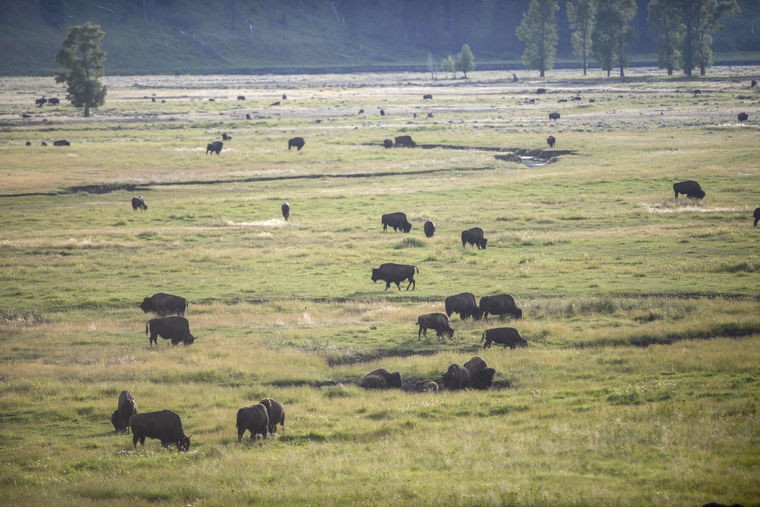Yellowstone National Park officials want to cap this winter’s cull of bison that migrate out of the park at a little more than a quarter of their August population count, according to a report they released late last week.
In the park’s bison status report, officials made a suite of management recommendations for this winter, including capping the total bison killed through hunting and shipping to slaughter at 1,250. The report also recommends not allowing the hunting of bison in the West Yellowstone area because the portion of the herd that migrates there has been shrinking.
The recommendations will be considered by the various state, federal and tribal officials involved in managing bison. They typically finalize the details of the winter cull at their meeting in November.
Yellowstone bison are managed under an agreement that calls for a population of 3,000. Bison managers work toward that goal through managed hunts and ship-to-slaughter operations each year when the bison leave Yellowstone National Park to look for forage at lower elevations.
Park biologists counted a total of 4,816 during aerial surveys this past August, a significant drop from the 5,500 counted in 2016. More than 1,200 were removed from the population last winter.
The agencies have moved away from setting an explicit removal goal in recent years, instead saying they simply want to decrease the population. The park’s status report says about 600 bison would need to be removed to keep the population from growing.
Last winter, 748 were shipped to slaughter, a controversial practice that bison advocates would like to end. The park’s status report says they plan to use the trap again this year.
Stephanie Adams, the Yellowstone program manager for National Parks Conservation Association, said in an emailed statement that it’s “disappointing that wildlife managers are once again proposing to ship hundreds of Yellowstone bison to slaughter.”
Yellowstone has been trying to set up a quarantine operation that would allow bison to be moved to tribal reservations as an alternative to slaughter. They’re holding a few dozen bison for that possibility, although it’s not yet clear when that program will be up and running.
Hunters killed 440 last winter. Bison migrate out of Yellowstone in two groups — the central herd goes west, the northern herd goes north. Of the bison taken by hunters last winter, 345 were killed on the north side of the park, near Gardiner. The other 95 were taken west of the park near West Yellowstone.
Yellowstone is recommending that hunters don’t kill bison west of the park this winter because the central herd has been declining. The status report says biologists counted 847 members of that herd this August, a roughly 42 percent decline from last year.
Rick Wallen, Yellowstone’s senior bison biologist, said in a Facebook video Tuesday that it’s not because the bison are dying. Instead, central herd bison are moving into the much larger northern herd and migrating out near Gardiner. He said they’ve been seeing this trend for more than 10 years.
Closing the west side to hunting, the park believes, could help preserve the animal’s western migration. But it would also likely send more hunters to Gardiner, where residents consistently complain about the safety of the hunt.
Jonathan Shafer, a park spokesman, said in an email that stopping the hunt there is practical if the agencies that manage the hunts “think it is important to preserve a western migration” and truly want to see bison move into new habitat north of West Yellowstone.
Hunting is managed by five tribal nations and the state of Montana, not the park. Montana Fish, Wildlife and Parks has already finalized its tag offerings for this year, including 40 tags for the west side.
Mike Volesky, chief of operations for FWP, said the state’s fish and wildlife commission could still amend that, and that the state will consider Yellowstone’s recommendation.
Montana Gov. Steve Bullock expanded where the animals are allowed within the state in 2015, allowing them to wander as far north as the Taylor Fork drainage. Bison haven’t moved into that habitat yet. But Tom McDonald, of the Confederated Salish and Kootenai Tribes, said closing hunting on the west side could make sense if there’s a plan to get the animals to use those lands.



